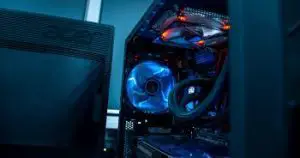Introduction
I’m really glad my first PC build went relatively smooth. Most hiccups I had were more related to software and driver installation. I took as many standard precautions as I could when it came to the build itself. One of those involved mitigating the effects of static on the PC’s parts. I don’t think most first time builders understand why static is an important concern when constructing, and every now and then someone posts about how their PC got fried because they were wearing fuzzy socks and built it on the carpet.
If you’re building a PC for the first time then I’m sure you’ll get a lot out of this.
In this article, I’ll go over everything you need to know to mitigate the effects of static electricity while you’re building your PC. There’s a lot of info on the web about the Do’s and Don’ts of how to get rid of static when building.
This is nothing to be intimidated by and the most important thing you can do is don’t overthink it.
What To Do Instead
Instead of building a PC directly on your carpet, build it on a desk and ensure you’re not wearing extremely fuzzy socks or clothing that makes you shock things. The easiest way to ensure you don’t have to worry about static is to plug in your power supply and DON’T turn it on. Touching it every time you install a new part is the best way to ensure you are grounding yourself.
Most of the posts I saw on Reddit were usually about how someone was wearing a full sweatshirt and sweatpants while they were building and then they heard the zap of death when they touched their motherboard.
How to Keep Yourself Discharged When Building
There are a couple of things you can do to keep yourself grounded while building.
The most common ways people ground themselves when handling electronics is by touching the computer case or the plugged-in power supply.
This is exactly what I did every time I moved on to putting in a new part. This stuff sounds simple, but it’s actually really important because you never know how charged up you or the person helping you is (especially if you’re coming in and out of the house, building your rig over the course of multiple days).
The reason I recommend grounding oneself this way is that modern PC cases are usually constructed in a way that naturally grounds them to whatever surface you’re on. Don’t take my word for this, but that should provide you with some reassurance.
Linus Tech Tips Explains It Best
Here are some other tips:
- Touch the case after installing every component (as we already mentioned)
- Wear an anti-static wrist strap. You might not need to go to this extreme, but they definitely work even if the internet says they’re overhyped.
- Don’t rub your socks on the carpet while you build.
- ESD mats will more than work if you’re that concerned with the dangers of static build-up. I would only recommend this to someone who has had a traumatic experience with static damaging their computer already or they are building a rig that’s either ungodly expensive or not their own.
There’s usually some items around your house that you can use to ground yourself. Touching a radiator or gas pipe in your house will surely do the trick. I’ve seen some people get creative with attaching crocodile clips to their metal wristband or just on a part of their body.
Other Ways to Ensure Safe PC Handling
These are some other last-minute things I gathered after doing some more research and pointing out some things I did during my build that helped a lot.
Keep your power supply (PSU) plugged in BUT turned off. Doing this will keep it completely grounded until you’re ready to actually turn it on. Your build doesn’t have to be fully completed in order for you to be able to safely turn it on to test it. It’s a safe practice to flip the power switch on the PSU when you first turn it on (instead of using the power button on the case).
When you plug the power supply into the wall outlet you are grounding the PC.
Work on a hard surface like a desk or a table. Most people that are ready to build a PC already have their desk ready to go right? If not, do your best to find a wooden surface or make sure the table isn’t completely made out of metal.
Avoid building on any type of floor. You’ll lose a ton of screws and bolts if you try to do it this way. It’s easier if you assort the bolts in containers on a desk. A desk makes it easier to utilize lamps and other light sources.
Will I have to worry about static AFTER my PC is done building?
Not really, unless you feel a shock every time you touch the mouse or other parts of your computer. As long as you’re not dragging it across the floor (which even then shouldn’t be an issue) then you can be assured there is no more risk of static affecting it. The only person who had an issue with getting shocked every time he touched his mouse was Linus Tech Tips back in 2009.
Again, I need to reiterate that this is not something you should be overly concerned about. By no means do I think you have to do everything mentioned in this article to ensure you’re building your PC in the safest manner possible. It takes a little bit of common sense and awareness and that’s it. If you have any questions or comments, feel free to reach out entertainmentden.ns@gmail.com and I’ll do my best to respond. Thank you for reading!
If you’re interested in any more information on my gaming PC, then check out my article on my first gaming PC build. In this article, I go over everything I learned throughout the process, myth-busting, and the complete list of parts I used.

